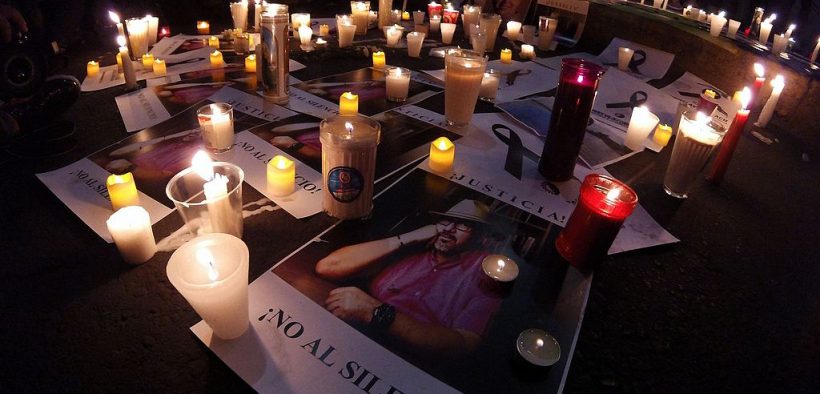Still Without Protection, Journalists Are Mexico’s Walking Dead

Mexico, already the most dangerous country for journalists in the Western Hemisphere, recorded more journalists deaths in the first seven months of 2019 than in all of 2018.
(By Parker Asmann, InSight Crime) Reporters in Mexico are frequently forced to confront brutal and often deadly violence, but the administration of recently elected President Andrés Manuel López Obrador has so far failed to do anything to ensure the protection of the country’s journalists.
At least 10 journalists have been killed in Mexico so far in 2019, making it the most dangerous country to practice the profession in the Western Hemisphere, according to the Committee to Protect Journalists (CPJ).
From 2000 to date, Mexico’s National Human Rights Commission (Comisión Nacional de los Derechos Humanos – CNDH) has recorded 151 cases of murdered journalists — the most in Latin America — of which at least 90 percent remain in impunity.
Most recently, three journalists were killed in the span of less than one week.
Jorge Celestino Ruiz Vázquez from the Gulf state of Veracruz’s El Gráfico newspaper was shot dead August 2. That same day, Edgar Alberto Nava López, the founder of La Verdad de Zihuatanejo in Guerrero state, was also shot and killed. Days earlier on July 30, another journalist from Guerrero, Rogelio Barragán Pérez, who founded the news website Guerrero Al Instante, was found beaten and murdered in the trunk of a car, according to CPJ.
Journalists in Mexico have long been targeted by a variety of actors, including organized crime groups, political operatives and powerful elites. Arguably the most high-profile incident to occur recently was the brazen May 2017 execution of one of the country’s most famous drug trade chroniclers, Javier Valdez Cárdenas. The Sinaloa-based reporter is believed to have been shot dead in the capital Culiacán in response to his reporting on internal power disputes within the Sinaloa Cartel.
The Protection Mechanism for Human Rights Defenders and Journalists, which was established in 2012, was designed to safeguard at-risk human rights activists and journalists from such targeted violence in Mexico. Ideally, journalists provided with protection undergo risk evaluations once or twice per year, maintain communications with authorities and are given resources like panic buttons or bodyguards.
However, in September 2018, funding for this program was set to run out. Amid outcry from civil society and press advocates, the administration of former President Enrique Peña Nieto later approved an emergency budget to ensure the program would operate through the end of the year.
But despite the implementation of such protection mechanisms — which several reporters murdered this year were enrolled in — the onslaught against media workers in Mexico has continued unabated.
InSight Crime Analysis
While President López Obrador has broken away from his predecessors by taking questions from reporters every weekday morning, he has been highly critical of journalists and largely silent on the continued attacks levied against them.
After his historic landslide victory in the 2018 presidential election, López Obrador vowed that his administration was “not going to allow the assassination of journalists.” But that promise rings hollow under the weight of the 10 journalists murdered so far this year.
As of the end of March 2019, the government has granted protection measures to 399 of 464 journalists (86 percent) who have requested such services since 2012, according to official data. However, these protections are too often absent when journalists need them most.
Indeed, Francisco Romero Díaz, a freelance crime reporter in Playa del Carmen in southeast Quintana Roo state, was given a “panic button” and four bodyguards after he requested extra protection following the murder of two of his colleagues — one of whom was also receiving federal protection — in August 2018, according to Reporters Without Borders.
But Romero Díaz’s bodyguards were nowhere to be found when he was beaten and then shot in the head after being lured to a nearby bar in the early morning hours of May 16 this year.
The federal protection program didn’t help Oaxaca-based journalist Jesús Hiram Moreno either, although he survived an attack that left him with a bullet in his arm and another lodged in his back.
While Moreno pledged to stay in Oaxaca after the ambush, others who have survived similar attacks and threats have abandoned their homes entirely. Following Romero Díaz’s murder, journalist Héctor Vazquez told López Obrador in May of this year that constant death threats forced him to flee his home in the Caribbean city of Tulum and hide out in Chetumal, the capital of Quintana Roo.
He explained how security forces had beat him for his reporting on official corruption. López Obrador responded by saying that he would fight to bring peace to the country, “that is our commitment and the challenge we have,” according to La Jornada Maya.
Local media workers in Mexico, who live and work in the same places they report on, are often disproportionately targeted and killed for their work. Unlike foreign correspondents or reporters at national publications, local journalists aren’t afforded the opportunity of leaving.
After the latest spate of killings, CPJ’s Mexico representative, Jan-Albert Hootsen, said the “inaction of President López Obrador’s federal government is inexcusable,” adding that the recent murders should not just “become another murder statistic,” but rather a “catalyst for a comprehensive plan to stamp out impunity.”
In just the first seven months of 2019, the number of Mexican journalists killed has already surpassed the nine that were murdered in 2018 — which at that time placed Mexico among the most dangerous countries in the world for reporters behind only conflict-ridden Afghanistan and Syria. While López Obrador’s administration fails to act, journalists are forced to fend for themselves as current federal protection measures fall short.













